Skin-Microbiome Assembly in Preterm Infants during the First Three Weeks of Life and Impact of Topical Coconut Oil Application
Abstract
:1. Introduction
2. Results
2.1. Succession of the Skin Microbiota of Preterm Infants in Both Control and Intervention Infants
2.2. Factors Associated with Diversity of the Preterm-Infant Skin Microbiome
2.3. Effect of Topical Coconut Oil on the Skin Microbiome
3. Discussion
4. Materials and Methods
4.1. Participant Recruitment and Sample Collection
4.2. DNA Extraction, PCR, and Amplicon Sequencing
4.3. Bioinformatics and Statistical Analysis
4.4. Quantification and Detection of Staphylococcus spp.
4.5. Quantification and Detection of Bifidobacterium spp.
Supplementary Materials
Author Contributions
Funding
Institutional Review Board Statement
Informed Consent Statement
Data Availability Statement
Acknowledgments
Conflicts of Interest
References
- Byrd, A.L.; Belkaid, Y.; Segre, J.A. The human skin microbiome. Nat. Rev. Microbiol. 2018, 16, 143–155. [Google Scholar] [CrossRef] [PubMed]
- Uberoi, A.; Bartow-McKenney, C.; Zheng, Q.; Flowers, L.; Campbell, A.; Knight, S.A.; Chan, N.; Wei, M.; Lovins, V.; Bugayev, J.; et al. Commensal microbiota regulates skin barrier function and repair via signaling through the aryl hydrocarbon receptor. Cell Host Microbe 2021, 29, 1235–1248.e8. [Google Scholar] [CrossRef] [PubMed]
- Coates, M.; Lee, M.J.; Norton, D.; MacLeod, A.S. The skin and intestinal microbiota and their specific innate immune systems. Front. Immunol. 2019, 10, 2950. [Google Scholar] [CrossRef]
- Gensollen, T.; Iyer, S.S.; Kasper, D.L.; Blumberg, R.S. How colonization by microbiota in early life shapes the immune system. Science 2016, 352, 539–544. [Google Scholar] [CrossRef] [PubMed]
- Harris-Tryon, T.A.; Grice, E.A. Microbiota and maintenance of skin barrier function. Science 2022, 376, 940–945. [Google Scholar] [CrossRef]
- Zheng, Y.; Hunt, R.L.; Villaruz, A.E.; Fisher, E.L.; Liu, R.; Liu, Q.; Cheung, G.Y.; Li, M.; Otto, M. Commensal Staphylococcus epidermidis contributes to skin barrier homeostasis by generating protective ceramides. Cell Host Microbe 2022, 30, 301–313.e9. [Google Scholar] [CrossRef]
- Chu, D.M.; Ma, J.; Prince, A.L.; Antony, K.M.; Seferovic, M.D.; Aagaard, K.M. Maturation of the infant microbiome community structure and function across multiple body sites and in relation to mode of delivery. Nat. Med. 2017, 23, 314–326. [Google Scholar] [CrossRef] [PubMed]
- Younge, N.E.; Araújo-Pérez, F.; Brandon, D.; Seed, P.C. Early-life skin microbiota in hospitalized preterm and full-term infants. Microbiome 2018, 6, 98. [Google Scholar] [CrossRef] [PubMed]
- Capone, K.A.; Dowd, S.E.; Stamatas, G.N.; Nikolovski, J. Diversity of the human skin microbiome early in life. J. Investig. Dermatol. 2011, 131, 2026–2032. [Google Scholar] [CrossRef]
- Pammi, M.; O’Brien, J.L.; Ajami, N.J.; Wong, M.C.; Versalovic, J.; Petrosino, J.F. Development of the cutaneous microbiome in the preterm infant: A prospective longitudinal study. PLoS ONE 2017, 12, e0176669. [Google Scholar] [CrossRef]
- Visscher, M.; Narendran, V. The ontogeny of skin. Adv. Wound Care 2014, 3, 291–303. [Google Scholar] [CrossRef] [PubMed]
- Dong, Y.; Speer, C.P.; Glaser, K. Beyond sepsis: Staphylococcus epidermidis is an underestimated but significant contributor to neonatal morbidity. Virulence 2018, 9, 621–633. [Google Scholar] [CrossRef] [PubMed]
- Boghossian, N.S.; Page, G.P.; Bell, E.F.; Stoll, B.J.; Murray, J.C.; Cotten, C.M.; Shankaran, S.; Walsh, M.C.; Laptook, A.R.; Newman, N.S.; et al. Late-onset sepsis in very low birth weight infants from singleton and multiple-gestation births. J. Pediatr. 2013, 162, 1120–1124.e1. [Google Scholar] [CrossRef] [PubMed]
- Salava, A.; Aho, V.; Lybeck, E.; Pereira, P.; Paulin, L.; Nupponen, I.; Ranki, A.; Auvinen, P.; Andersson, S.; Lauerma, A. Loss of cutaneous microbial diversity during first 3 weeks of life in very low birthweight infants. Exp. Dermatol. 2017, 26, 861–867. [Google Scholar] [CrossRef]
- Ness, M.J.; Davis, D.M.; Carey, W.A. Neonatal skin care: A concise review. Int. J. Dermatol. 2013, 52, 14–22. [Google Scholar] [CrossRef]
- Salam, R.A.; Das, J.K.; Darmstadt, G.L.; Bhutta, Z.A. Emollient therapy for preterm newborn infants–evidence from the developing world. BMC Public Health 2013, 13, S31. [Google Scholar] [CrossRef]
- Edwards, W.H.; Conner, J.M.; Soll, R.F.; Group VONNSCS. The effect of prophylactic ointment therapy on nosocomial sepsis rates and skin integrity in infants with birth weights of 501 to 1000 g. Pediatrics 2004, 113, 1195–1203. [Google Scholar] [CrossRef]
- Fischer, C.L.; Blanchette, D.R.; Brogden, K.A.; Dawson, D.V.; Drake, D.R.; Hill, J.R.; Wertz, P.W. The roles of cutaneous lipids in host defense. Biochim. Et Biophys. Acta (BBA)-Mol. Cell Biol. Lipids 2014, 1841, 319–322. [Google Scholar] [CrossRef]
- Carpo, B.G.; Verallo-Rowell, V.M.; Kabara, J. Novel antibacterial activity of monolaurin compared with conventional antibiotics against organisms from skin infections: An in vitro study. J. Drugs Dermatol. JDD 2007, 6, 991–998. [Google Scholar]
- Strunk, T.; Pupala, S.; Hibbert, J.; Doherty, D.; Patole, S. Topical coconut oil in very preterm infants: An open-label randomised controlled trial. Neonatology 2018, 113, 146–151. [Google Scholar] [CrossRef]
- Davis, N.M.; Proctor, D.M.; Holmes, S.P.; Relman, D.A.; Callahan, B.J. Simple statistical identification and removal of contaminant sequences in marker-gene and metagenomics data. Microbiome 2018, 6, 226. [Google Scholar] [CrossRef] [PubMed]
- Skabytska, Y.; Biedermann, T. Staphylococcus epidermidis sets things right again. J. Investig. Dermatol. 2016, 136, 559–560. [Google Scholar] [CrossRef] [PubMed]
- Capone, K.A.; Friscia, D.L.; Nikolovski, J.; Telofski, L.S.; Stamatas, G.N. A randomized clinical study on the effects of emollient use on the developing infant skin microbiome and metabolome. Exp. Dermatol. 2023, 32, 75. [Google Scholar] [CrossRef]
- Glatz, M.; Jo, J.-H.; Kennedy, E.A.; Polley, E.C.; Segre, J.A.; Simpson, E.L.; Kong, H.H. Emollient use alters skin barrier and microbes in infants at risk for developing atopic dermatitis. PLoS ONE 2018, 13, e0192443. [Google Scholar] [CrossRef]
- Fischer, N.; Darmstadt, G.L.; Shahunja, K.; Crowther, J.M.; Kendall, L.; Gibson, R.A.; Ahmed, T.; A Relman, D. Topical emollient therapy with sunflower seed oil alters the skin microbiota of young children with severe acute malnutrition in Bangladesh: A randomised, controlled study. J. Glob. Health 2021, 11, 04047. [Google Scholar] [CrossRef] [PubMed]
- Abbas, A.A.; Assikong, E.B.; Akeh, M.; Upla, P.; Tuluma, T. Antimicrobial activity of coconut oil and its derivative (lauric acid) on some selected clinical isolates. Int. J. Med. Sci. Clin. Invent. 2017, 4, 3173–3177. [Google Scholar]
- Strunk, T.; Gummer, J.; Abraham, R.; Abraham, S.; Hibbert, J.; Patole, S.; Currie, A. Topical coconut oil contributes to systemic monolaurin levels in very preterm infants. Neonatology 2019, 116, 299–301. [Google Scholar] [CrossRef]
- Ruzin, A.; Novick, R.P. Equivalence of lauric acid and glycerol monolaurate as inhibitors of signal transduction in Staphylococcus aureus. J. Bacteriol. 2000, 182, 2668–2671. [Google Scholar] [CrossRef]
- Krislee, A.; Fadly, C.; Nugrahaningsih, D.A.A.; Nuryastuti, T.; Nitbani, F.O.; Jumina; Sholikhah, E.N. (Eds.) The 1-monolaurin inhibit growth and eradicate the biofilm formed by clinical isolates of Staphylococcus epidermidis. In BMC Proceedings; Springer: Berlin/Heidelberg, Germany, 2019. [Google Scholar]
- Tangwatcharin, P.; Khopaibool, P. Activity of virgin coconut oil, lauric acid or monolaurin in combination with lactic acid against Staphylococcus aureus. Southeast Asian J. Trop. Med. Public Health 2012, 43, 969–985. [Google Scholar]
- Bolyen, E.; Rideout, J.R.; Dillon, M.R.; Bokulich, N.A.; Abnet, C.C.; Al-Ghalith, G.A.; Alexander, H.; Alm, E.J.; Arumugam, M.; Asnicar, F.; et al. Reproducible, interactive, scalable and extensible microbiome data science using QIIME 2. Nat. Biotechnol. 2019, 37, 852–857. [Google Scholar] [CrossRef]
- Callahan, B.J.; McMurdie, P.J.; Rosen, M.J.; Han, A.W.; Johnson, A.J.A.; Holmes, S.P. DADA2: High-resolution sample inference from Illumina amplicon data. Nat. Methods 2016, 13, 581–583. [Google Scholar] [CrossRef] [PubMed]
- Oksanen, J.; Kindt, R.; Legendre, P.; O’hara, B.; Stevens, M.; Oksanen, M.; Suggests, M. The Vegan Package: Community Ecology Package; R Foundation for Statistical Computing: Vienna, Austria, 2007; Volume 1, pp. 1–190. [Google Scholar]
- Lahti, L.; Shetty, S. Introduction to the Microbiome R Package. 2018. Available online: https://microbiomegithubio/tutorials (accessed on 10 July 2022).
- Legendre, P.; De Cáceres, M. Beta diversity as the variance of community data: Dissimilarity coefficients and partitioning. Ecol. Lett. 2013, 16, 951–963. [Google Scholar] [CrossRef]
- Wickham, H.; Chang, W.; Wickham, M.H. Package ‘ggplot2’. Create elegant data visualisations using the grammar of graphics. In R package Version 3; Posit PBC: Boston, MA, USA, 2016; Volume 2, pp. 1–189. [Google Scholar]
- Mallick, H.; Rahnavard, A.; McIver, L.J.; Ma, S.; Zhang, Y.; Nguyen, L.H.; Tickle, T.L.; Weingart, G.; Ren, B.; Schwager, E.H. Multivariable association discovery in population-scale meta-omics studies. PLoS Comput. Biol. 2021, 17, e1009442. [Google Scholar] [CrossRef] [PubMed]
- Penders, J.; Vink, C.; Driessen, C.; London, N.; Thijs, C.; Stobberingh, E.E. Quantification of Bifidobacterium spp., Escherichia coli and Clostridium difficile in faecal samples of breast-fed and formula-fed infants by real-time PCR. FEMS Microbiol. Lett. 2005, 243, 141–147. [Google Scholar] [CrossRef]
- Okolie, C.E.; Wooldridge, K.G.; Turner, D.P.; Cockayne, A.; James, R. Development of a new pentaplex real-time PCR assay for the identification of poly-microbial specimens containing Staphylococcus aureus and other staphylococci, with simultaneous detection of staphylococcal virulence and methicillin resistance markers. Mol. Cell. Probes 2015, 29, 144–150. [Google Scholar] [CrossRef]
- Nakagawa, S.; Taneike, I.; Mimura, D.; Iwakura, N.; Nakayama, T.; Emura, T.; Kitatsuji, M.; Fujimoto, A.; Yamamoto, T. Gene sequences and specific detection for Panton-Valentine leukocidin. Biochem. Biophys. Res. Commun. 2005, 328, 995–1002. [Google Scholar] [CrossRef]
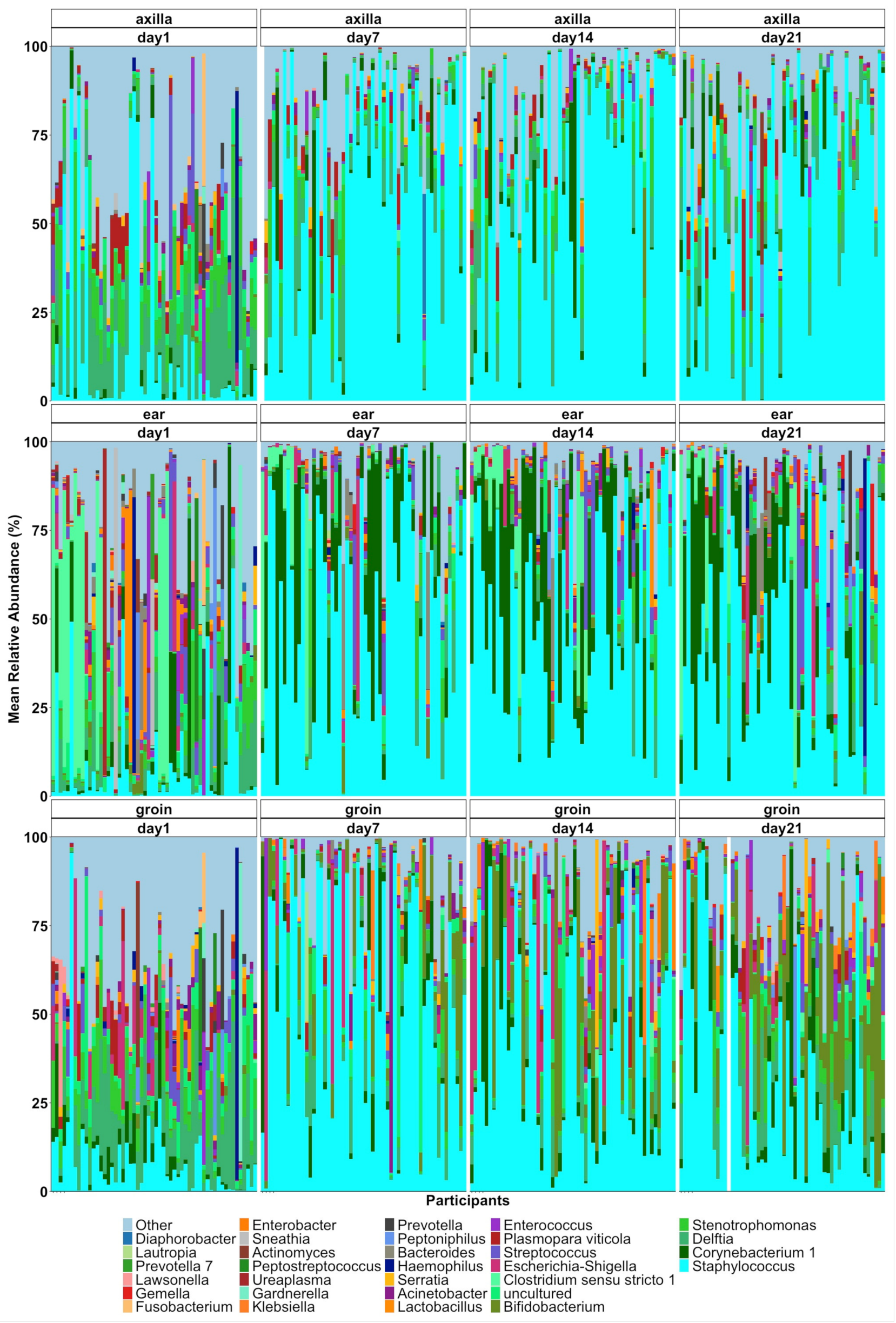
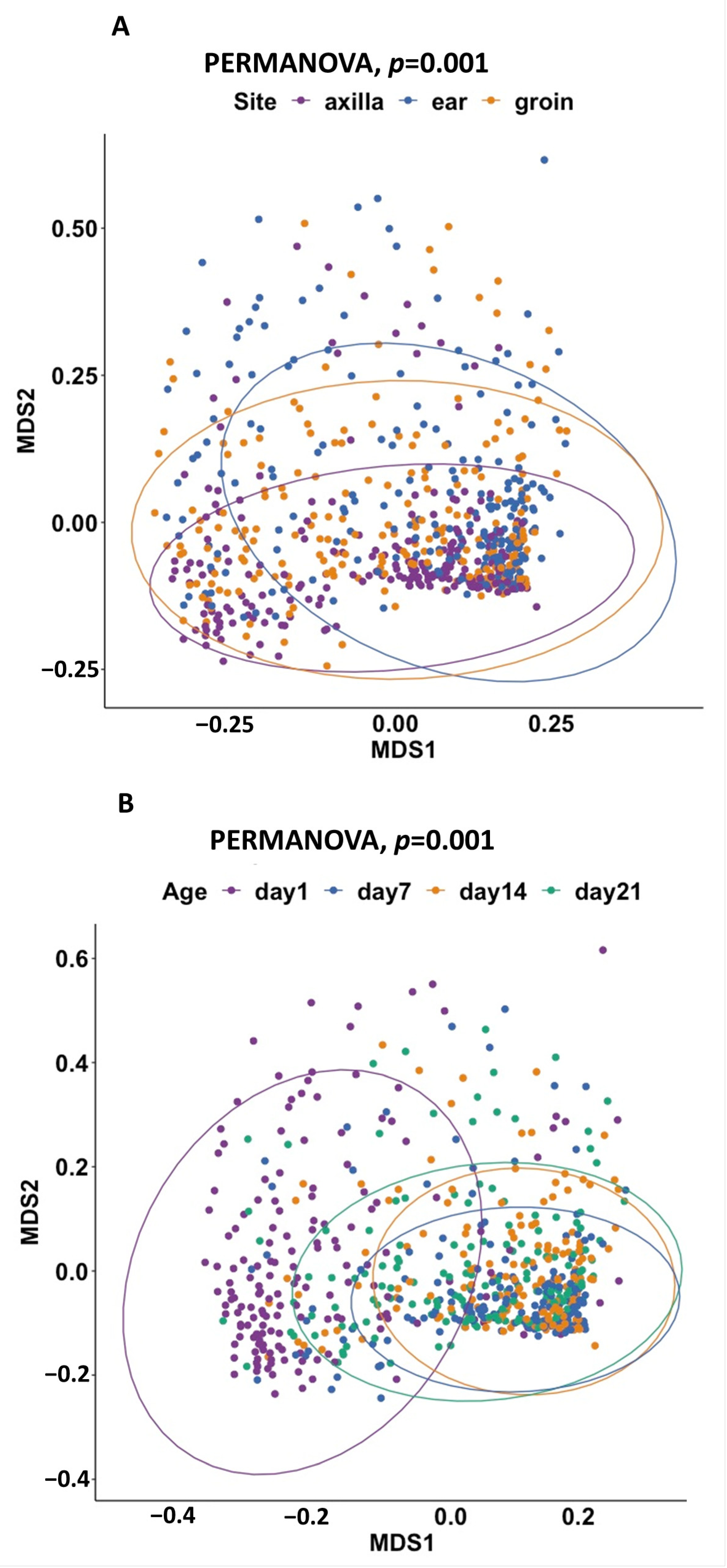
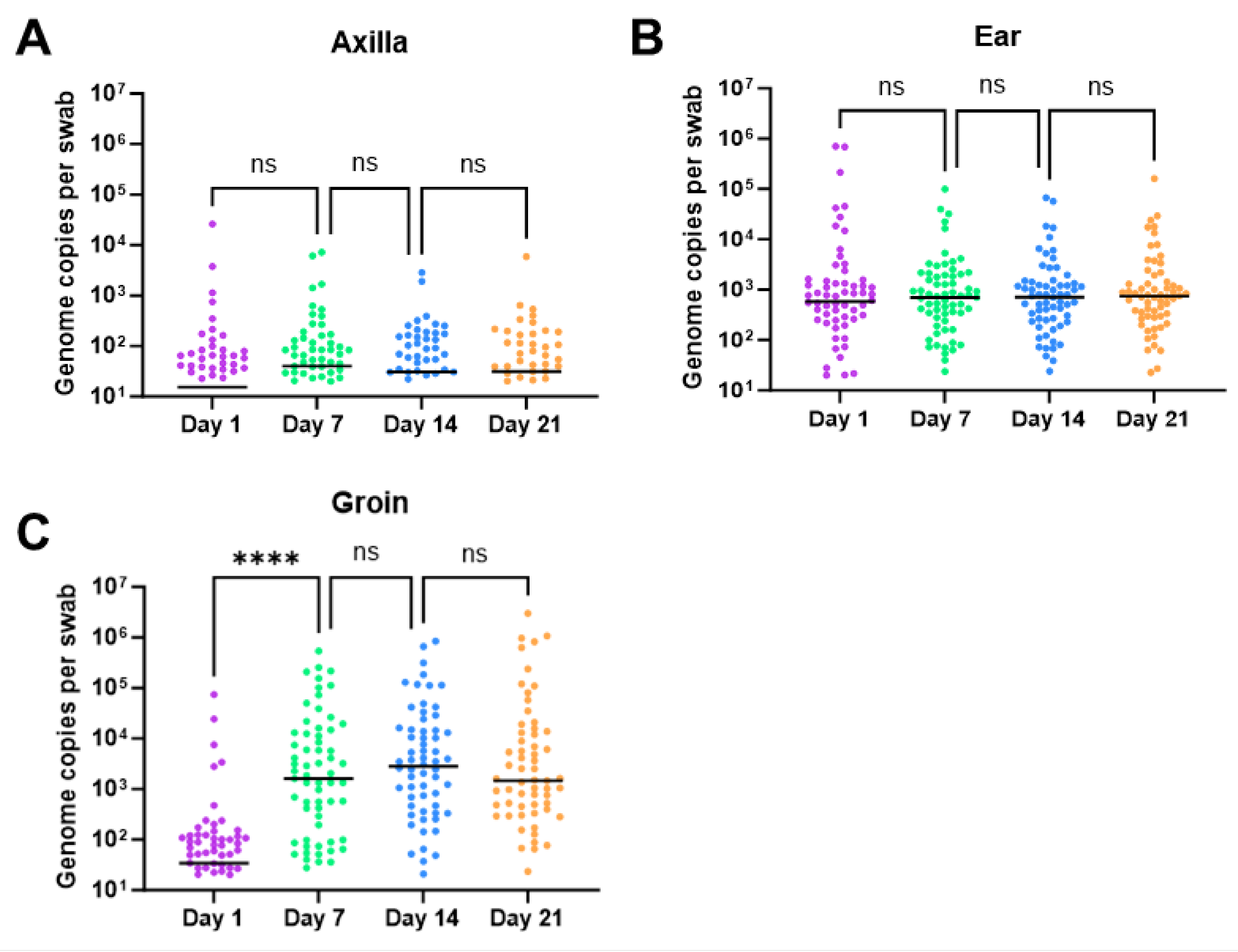

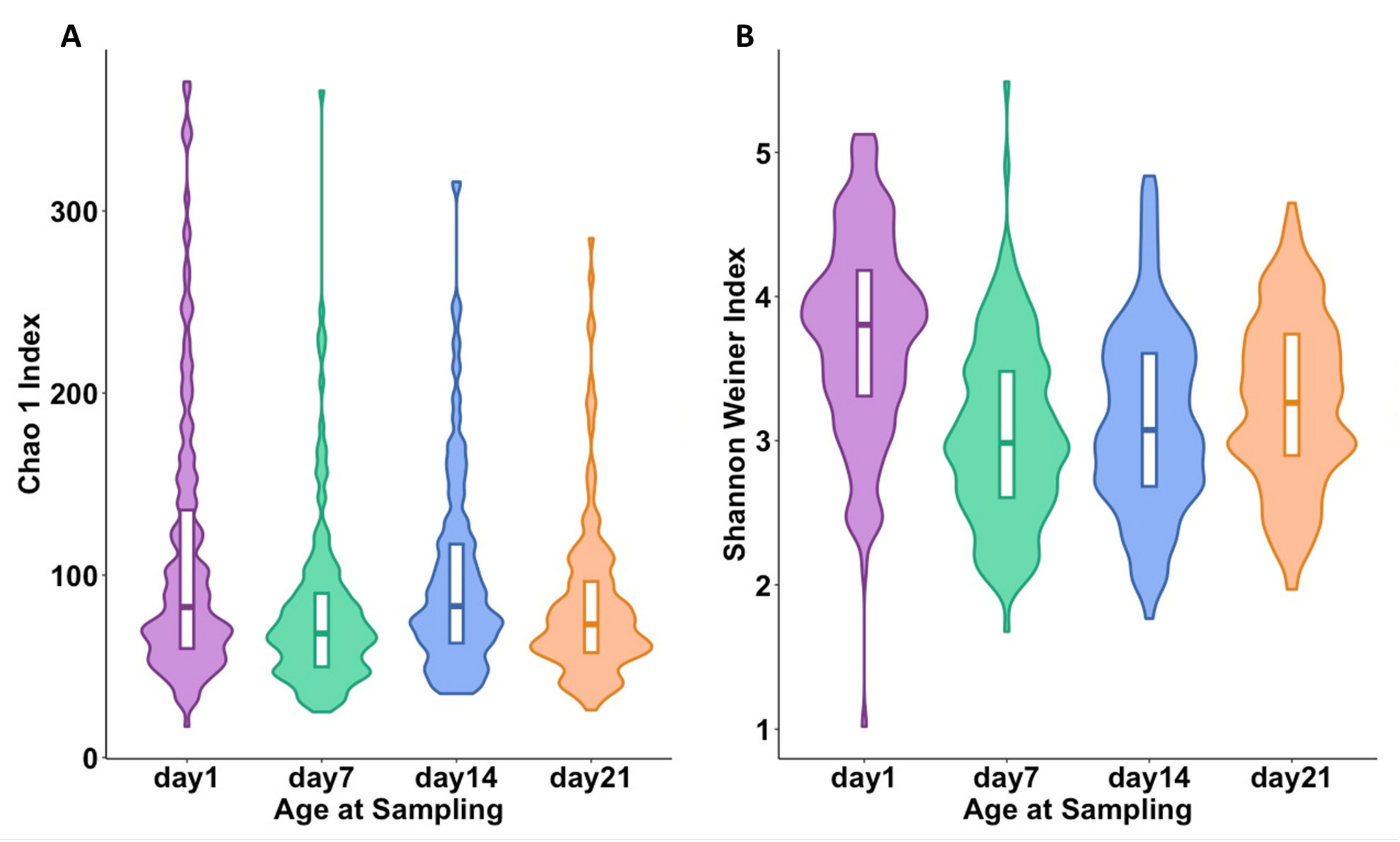
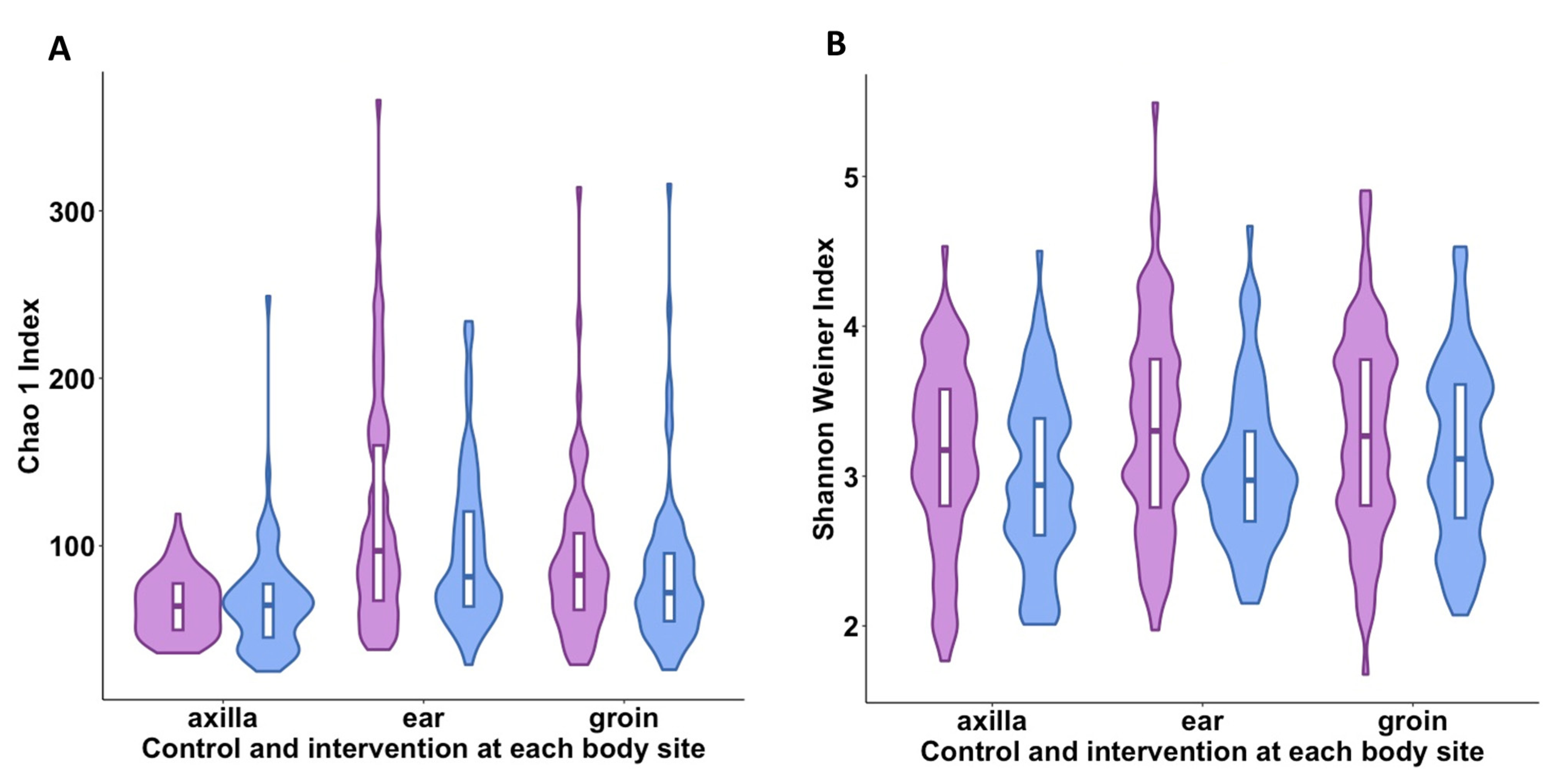
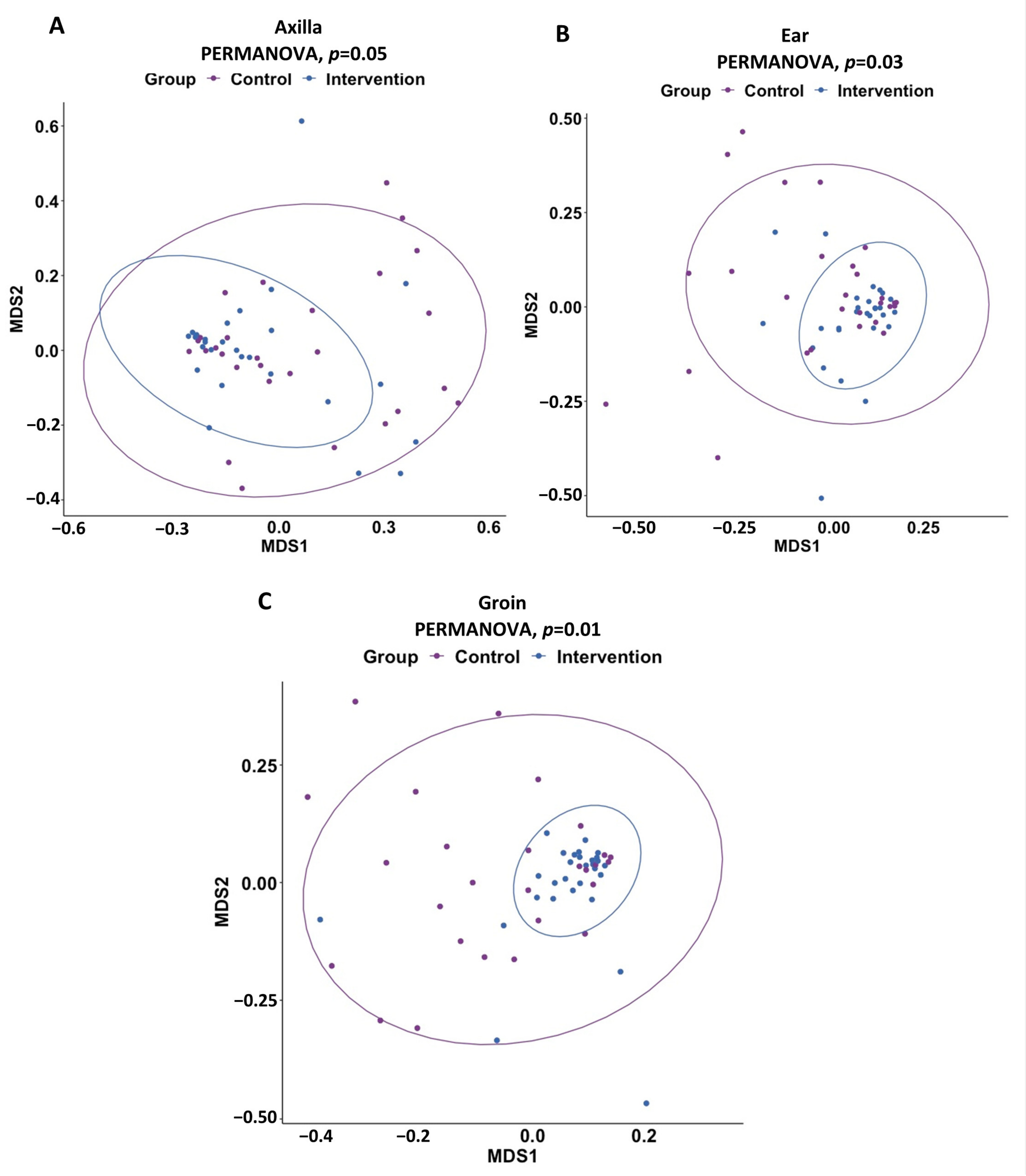
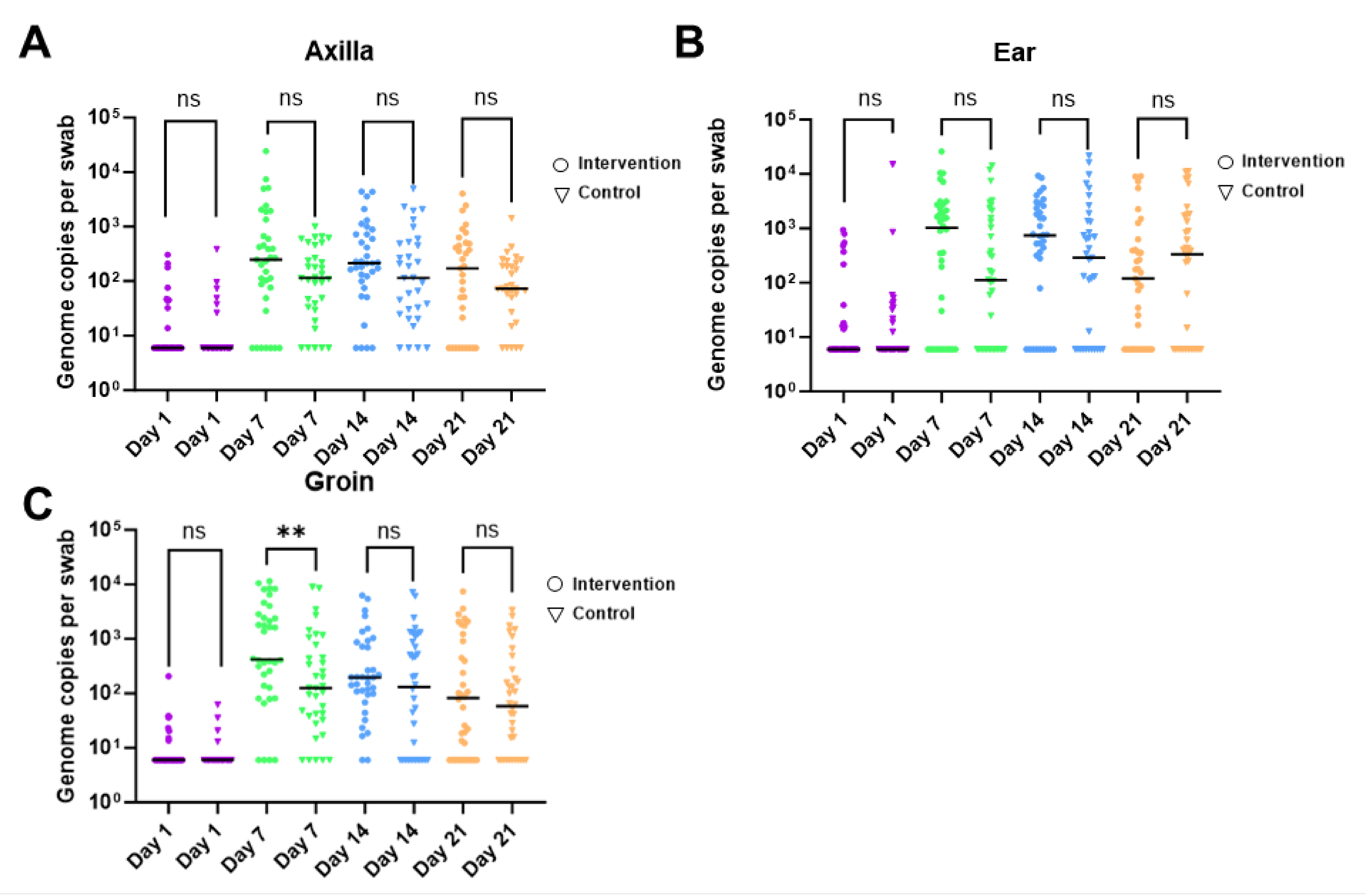
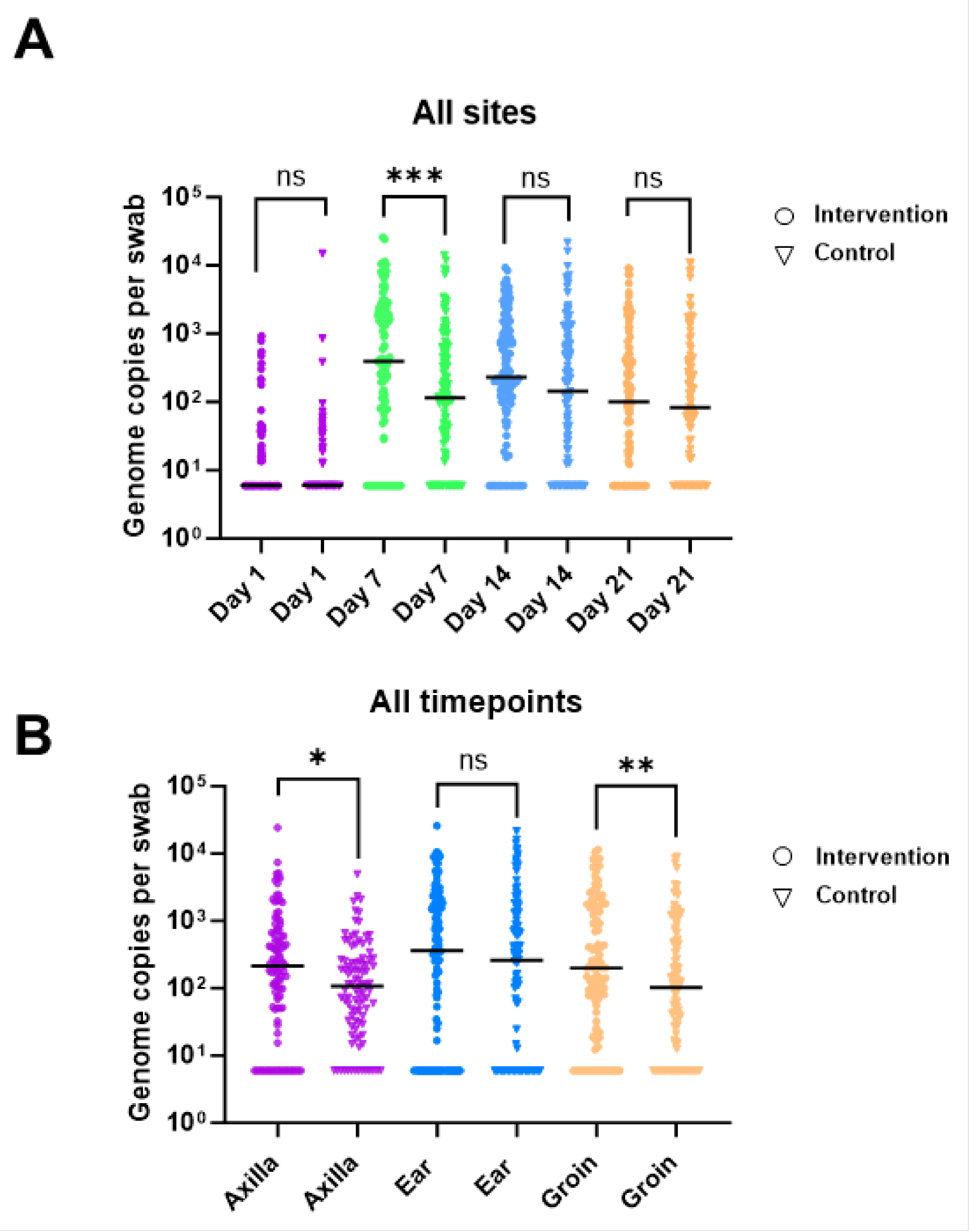
| Characteristics | Control Arm (n = 28) | Intervention Arm (n = 28) |
|---|---|---|
| Gestation (weeks) | 28 (23.7–29.5) | 27.6 (24.1–29.3) |
| Birth weight (g) | 984 (424–1534) | 1040 (590–1420) |
| Caesarean delivery | 18 | 15 |
| Male | 13 | 19 |
| Taxon | Reference | Condition | Coefficient | q-Value |
|---|---|---|---|---|
| Corynebacterium | Axilla | Groin | −2.31 | 0.0001 |
| Clostridium | Axilla | Groin | −1.84 | 9.46 × 10−5 |
| Streptococcus | Axilla | Groin | 1.77 | 0.002 |
| Staphylococcus | Day 1 | Day 7 | 1.68 | 2.43 × 10−9 |
| Staphylococcus | Day 1 | Day 14 | 1.71 | 2.18 × 10−9 |
| Bifidobacterium | Day 1 | Day 7 | 1.88 | 0.006 |
| Cutibacterium | Day 1 | Day 14 | −1.88 | 0.0003 |
Disclaimer/Publisher’s Note: The statements, opinions and data contained in all publications are solely those of the individual author(s) and contributor(s) and not of MDPI and/or the editor(s). MDPI and/or the editor(s) disclaim responsibility for any injury to people or property resulting from any ideas, methods, instructions or products referred to in the content. |
© 2023 by the authors. Licensee MDPI, Basel, Switzerland. This article is an open access article distributed under the terms and conditions of the Creative Commons Attribution (CC BY) license (https://creativecommons.org/licenses/by/4.0/).
Share and Cite
Ghori, N.-U.-H.; Mullally, C.A.; Nicol, M.P.; Currie, A.; Hibbert, J.; Payne, M.S.; Patole, S.; Strunk, T. Skin-Microbiome Assembly in Preterm Infants during the First Three Weeks of Life and Impact of Topical Coconut Oil Application. Int. J. Mol. Sci. 2023, 24, 16626. https://doi.org/10.3390/ijms242316626
Ghori N-U-H, Mullally CA, Nicol MP, Currie A, Hibbert J, Payne MS, Patole S, Strunk T. Skin-Microbiome Assembly in Preterm Infants during the First Three Weeks of Life and Impact of Topical Coconut Oil Application. International Journal of Molecular Sciences. 2023; 24(23):16626. https://doi.org/10.3390/ijms242316626
Chicago/Turabian StyleGhori, Noor-Ul-Huda, Christopher A. Mullally, Mark P. Nicol, Andrew Currie, Julie Hibbert, Matthew S. Payne, Sanjay Patole, and Tobias Strunk. 2023. "Skin-Microbiome Assembly in Preterm Infants during the First Three Weeks of Life and Impact of Topical Coconut Oil Application" International Journal of Molecular Sciences 24, no. 23: 16626. https://doi.org/10.3390/ijms242316626
APA StyleGhori, N.-U.-H., Mullally, C. A., Nicol, M. P., Currie, A., Hibbert, J., Payne, M. S., Patole, S., & Strunk, T. (2023). Skin-Microbiome Assembly in Preterm Infants during the First Three Weeks of Life and Impact of Topical Coconut Oil Application. International Journal of Molecular Sciences, 24(23), 16626. https://doi.org/10.3390/ijms242316626






